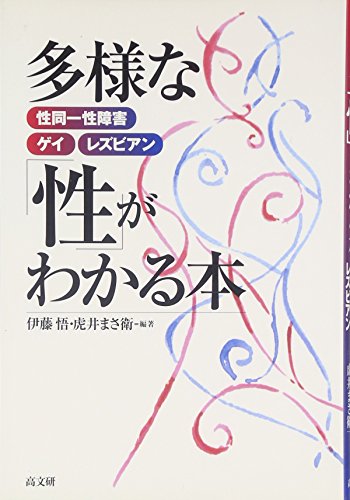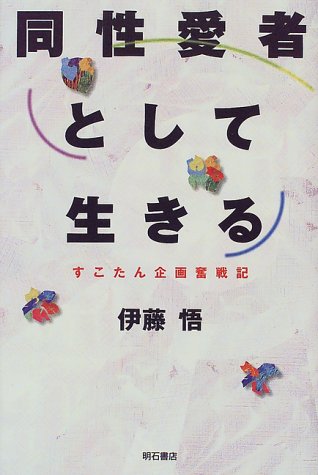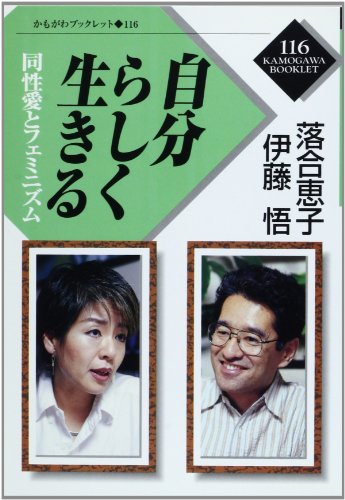8 0 0 0 多様な「性」がわかる本 : 性同一性障害・ゲイ・レズビアン
- 著者
- 伊藤悟 虎井まさ衛編著
- 出版者
- 高文研
- 巻号頁・発行日
- 2002
7 0 0 0 男ふたり暮らし : ぼくのゲイ・プライド宣言
5 0 0 0 同性愛って何? : わかりあうことから共に生きるために
- 著者
- 伊藤悟 [ほか] 著
- 出版者
- 緑風出版
- 巻号頁・発行日
- 2003
5 0 0 0 同性愛者として生きる : すこたん企画奮戦記
4 0 0 0 自分らしく生きる : 同性愛とフェミニズム
3 0 0 0 IR 認知地図の歪みの成分に関する一考察 - 金沢市中心部を事例として -
- 著者
- 若林 芳樹 伊藤 悟
- 出版者
- 東京地学協会 = Tokyo Geographical Society
- 雑誌
- 地學雜誌 (ISSN:0022135X)
- 巻号頁・発行日
- vol.103, no.3, pp.221-232, 1994-06-25
- 参考文献数
- 34
- 被引用文献数
- 4 6
Geographical approach to cognitive maps has mainly focused on measurement of their spatial patterns. Recently Lloyd (1989) devised a useful method for analyzing the components of distortions in cognitive maps by means of Euclidean regression. Until now, however, this method has not yet been validated. The purpose of this study was to reexamine his concepts about the distortions in cognitive maps and to test their validity.We pointed out several discrepancies between the concepts of distortions and their operational definitions given by Lloyd (1989). To overcome this problem, the absolute distortion that appears in the configuration before Euclidean regression ought to be distinguished from the systematic distortion that is measured by the parameters of Euclidean regression. While the systematic distortion that indicates a Euclidean property of the distortion can be explained by alignment and rotation heuristics (Tversky, 1981) and implicit scaling model (Holyoak and Mah, 1982), the relative distortion that remains after Euclidean regression cannot be explained by general theories. In addition, these geometrical components of distortion ought to be distinguished from statistical ones, namely, distortion (central tendency) and fuzziness (dispersion) defined by Gale (1982).On the basis of this conceptualization, we carried out an empirical analysis of the distortion in the cognitive map of Kanazawa City. The data used in this study were obtained by a conditional sketch mapping drawn from 113 students of Kanazawa University. Locations to be answered were 21 transportation nodes within the central part of the city known by more than 90 percent of the students. From these locations, two major landmarks of CBD were selected as reference points. Subjects were asked to indicate the remaining 19 locations on the legal-size sheet in which the two reference points were printed.We detected the absolute distortions, overlaying the cognitive maps for all samples on the actual map so as to fit the locations of two reference points into the actual ones. The patterns of the absolute distortion indicated that the amount of errors increased with distance from the reference points, and that the locations in cognitive maps commonly shifted outward from the actual ones. Specifically, these displaced locations in southern or eastern part of the city indicated a counterclockwise shift, which suggested a directional bias in cognitive maps.In order to separate the systematic distortion from the relative one, each of the cognitive configurations was fitted into the actual map by Euclidean regression. Parameter estimates of the scale change averaged 0.593, which suggested that cognitive maps were enlarged about twice the size of the actual map. Mean direction of the rotated angle amounted to-22.2 degrees, which implied that cognitive maps were rotated counterclockwise about 20 degrees from the actual map so as to coordinate the cardinal directions of the cognitive map with the actual one. This tendency can be due to the displacement of two river channels as major reference lines in Kanazawa from cardinal directions.After eliminating the systematic distortions by Euclidean regression, the actual map was overlaid with all the cognitive maps. The overlaid maps indicated that the local patterns of relative distortions reflected hierarchical structure of cognitive maps (Stevens and Coupe, 1978) although the amount of them was smaller than that of the systematic distortions.
- 著者
- 柳 長門 伊藤 悟 寺﨑 義朗
- 出版者
- 公益社団法人 低温工学・超電導学会 (旧 社団法人 低温工学協会)
- 雑誌
- 低温工学 (ISSN:03892441)
- 巻号頁・発行日
- vol.54, no.1, pp.10-22, 2019-01-20 (Released:2019-02-11)
- 参考文献数
- 56
- 被引用文献数
- 1 3
Aiming at application to future fusion reactor magnets, the development of large-current capacity high-temperature superconducting (HTS) conductors has started around the world. The present status of various conductor concepts and their properties are introduced. Future prospects are also discussed.
2 0 0 0 IR 処女膜閉鎖症の1例と本邦で発生した184例の文献的考察
- 著者
- 高橋 洋平 田中 優 甲斐 由佳 平野 浩紀 中谷 貴美子 伊藤 悟志
- 雑誌
- 高知赤十字病院医学雑誌 = Medical Journal of Kochi Red Cross Hospital (ISSN:09197427)
- 巻号頁・発行日
- vol.22, no.1, pp.49-55, 2018-03
処女膜閉鎖症は,尿生殖洞の発生異常により生じる比較的稀な疾患として知られている.症例は11 歳女性.初経は未発来.持続する下腹部痛を主訴に来院し,MRI にて腟留血腫を認め,手術時に外陰部の視診で腟口の閉鎖と閉鎖部位に薄い膜が膨隆しており診断に至った.処女膜切開,貯留血の排出を行い,切開部位の縫合を行った.術後は子宮・腟形態の回復を認め,月経も発来しており順調に経過している.本邦での発生例184 例の文献的考察を加えて報告する.
2 0 0 0 地理教育用AR(拡張現実)情報システム(5)
- 著者
- 伊藤 悟 鵜川 義弘 福地 彩 秋本 弘章 堤 純 井田 仁康 大西 宏冶
- 出版者
- 公益社団法人 日本地理学会
- 雑誌
- 日本地理学会発表要旨集
- 巻号頁・発行日
- vol.2015, 2015
本発表は、昨年と今年の日本地理学会春季学術大会において同じ題目のもとにシリーズで行った4件の発表に続くもので、その後のシステム整備の進展や、未発表の利用実践を話題にする。具体的には、システム整備の新たな進展としてパノラマ写真との連動機能を、利用実践としては小学生らのオリエンテーリングを報告する。
2 0 0 0 OA 北陸地方における都市のイメージとその地域的背景
- 著者
- 伊藤 悟
- 出版者
- 一般社団法人 人文地理学会
- 雑誌
- 人文地理 (ISSN:00187216)
- 巻号頁・発行日
- vol.46, no.4, pp.353-371, 1994-08-28 (Released:2009-04-28)
- 参考文献数
- 38
- 被引用文献数
- 3 2
The purpose of this study is to clarify the image and its regional background of cities in the Hokuriku District, Central Japan. The methodological framework consists of three preparatory questionnaire surveys, semantic differential (SD) method combined with direct factor analysis, and step-wise multiple regression analysis.Through the preparatory surveys, 18 municipalities (shi) were selected for the analysis as well-known Hokuriku cites in the Niigata, Toyama, Ishikawa and Fukui Prefectures, and 12 pairs of bipolar adjective words were gathered as the rating scales of the image evaluation in the questionnaire of the SD method. Undergraduate students of Kanazawa University located in Kanazawa-shi, Ishikawa Prefecture are the subject for the SD questionnaire, as well as the three preparatory ones.In order to extract the dimension of the city image, the evaluation data derived from the SD questionnaire was subjected to the factor analysis by the direct method, which does not standardize the data and thus starts with the cross-product matrix. Step-wise regression analysis was also utilized for searching the regional characteristics for the backgrounds of the image dimensions in the Hokuriku cities.As a result, three image dimensions were obtained. The first can be interpreted as 'yearning' for city since it is concerned with the adjectives 'urban' and 'lively'. Commercial activity and population size affect this dimension. In the Hokuriku cities, the most desired cities are Niigata-shi and Kanazawa-shi, where commercial activities have been highly concentrated and the population are largest.The second dimension is interpreted as psychological distance, or imaginary 'separation' for city. Real distance to a city increases this separation, and the population size of the city decreases it. The third is 'hesitation', which arises for far distant and industrial or transportation cities. On the other hand, the hesitation is less for Kanazawa-shi, the nearest city for the students, and Wajima-shi and Kaga-shi, which are tourist and spa resort places.
平成16〜17年度の2年間における本研究課題では、リバブル・シティとしての評価が高いカナダ・バンクーバーとオーストラリア・メルボルンにおける公共交通網を基軸とした都市圈整備に関する現地調査を実施し、わが国における都市圈整備の方向性を検討することを目的とした。その研究成果の概要は、次の通りである。1.バンクーバー都市圈では、1970年代からの取り組みをベースにしたGVRDによる"Livable RegionStrategic Plan"を基に、公共交通網の再整備と結びついたコンパタトで高密度な街づくりが郊外タウンセンターで実践され、利便性の高い日常生活拠点として整備されている。2.メルボルン都市圈では、1990年代から取り組んできた市街地拡教化防止のための土地利用規制に加えて、2002年に第定されだMelbourne 2030"による持続可能な都市圈整備の取り組みがスタートし、郊外のディストリクト・センターを中心に公共交通でもアクセズ可能で、多様な機能集積による利便性の高い中心地形成が進められている。3.これらの両都市圈での詳細な土地利用調査や公共交通網整備の状況などから、21世紀の持続可能な都市整備方針としてのリバブル・シティの特性の一端を明らかにすることができた。4.わが国でのリバブル・シティ形成の可能性は、東京、大阪など公共交通網の発達した大都市部では高い実現性を有するが、反面、過密な人口密度などによる弊害をどのように緩和するか等の新たな課題が生じる。地方都市部では、低い人口密度とモータリゼーションにより、持続可能な市街地整備の必要性が一層高まっているが、その状況はむしろ悪化しつつある。高齢化の進展などに対応したバリアフリー化などの視点からの再整備が有効であると考えられる。
1 0 0 0 OA 感染性脳炎と非感染性脳炎
- 著者
- 伊藤 悟
- 出版者
- 日本神経治療学会
- 雑誌
- 神経治療学 (ISSN:09168443)
- 巻号頁・発行日
- vol.34, no.3, pp.215-218, 2017 (Released:2017-10-14)
- 参考文献数
- 7
In the inflammatory disease of the central nervous system, there are meningitis that inflammation is limited in a subarachnoid cavity and encephalitis that inflammation also occur in brain. Because of the high mortality rate and severe aftereffect particularly in encephalitis, early diagnosis and start of therapy are important. The diagnosis of encephalitis is made on the basis of clinical symptoms and cerebrospinal fluid abnormalities. Many cases often need to receive general care in the intensive care unit because of the serious condition. Bacteria, virus, tuberculosis, fungus, parasitic worm and prion protein are representative as causes of infectious encephalitis. Most of the non–infectious encephalitis is caused by autoimmune disease, including connective tissue disease, Behçet's disease, sarcoidosis, paraneoplasic encephalopathy and Hashimoto disease. According to fundamental differences for medical treatment, it is very important to distinguish infectiousness and non–infectiousness encephalitis. I explain the main point of the differential diagnosis, mainly on neurological examination, findings of radiological imaging and an examination of cerebrospinal fluid.
- 著者
- 湯田 ミノリ 伊藤 悟 内田 均 木津 吉永 伊東 純也
- 出版者
- Tokyo Geographical Society
- 雑誌
- 地學雜誌 (ISSN:0022135X)
- 巻号頁・発行日
- vol.117, no.2, pp.341-353, 2008-04-25
- 参考文献数
- 21
- 被引用文献数
- 2 4
The use of GIS in education in Japan has not yet been widely diffused, although the computer and network environments of schools have been improved, and teachers have already recognized the characteristics and advantages of this tool in education.<br> Nowadays, GIS has been intergraded into many aspects of our lives. Mobile phones are also basic tools in our daily lives. A GIS application that runs on cellular phones would be helpful in school education.<br> From this point of view, the authors have developed a system called Cellular Phone GIS including a GIS application for mobile phone (hereinafter Cell Phone GIS Application) and its web-based GIS viewer application for PC using Google maps (hereinafter PC viewer), and carried out fieldwork at an upper secondary school using these tools. Data can be input and edited outdoors with the Cell Phone GIS Application. These data can be viewed on both cellular phones and personal computers via the Internet. Students carried out a land use survey in the area around the school with the Cell Phone GIS Application, and examined and presented the results using the PC viewer in class.<br> Students participated actively in the fieldwork with the cellular phone. Through experience of the survey with the tool, they found many new things and learned to adopt multi-dimensional points of view and ways of thinking. Also, this project generated more interest among students in geography classes.<br> The Cell Phone GIS Application provided high school students with a feeling of accomplishment from the fieldwork. Meanwhile, this tool and PC viewer minimized work after fieldwork because users do not have to input and aggregate data again. Therefore, teachers and students can use course hours efficiently. The Cellular Phone GIS can provide an environment in which students are able to receive educational effects from fieldwork.
- 著者
- 湯田 ミノリ 伊藤 悟 内田 均 木津 吉永 伊東 純也
- 出版者
- 東京地学協会 = Tokyo Geographical Society
- 雑誌
- 地學雜誌 = Journal of geography (ISSN:0022135X)
- 巻号頁・発行日
- vol.117, no.2, pp.341-353, 2008-01-01
- 被引用文献数
- 4
金沢大学人間社会研究域人間科学系The use of GIS in education in Japan has not yet been widely diffused, although the computer and network environments of schools have been improved, and teachers have already recognized the characteristics and advantages of this tool in education. Nowadays, GIS has been intergraded into many aspects of our lives. Mobile phones are also basic tools in our daily lives. A GIS application that runs on cellular phones would be helpful in school education. From this point of view, the authors have developed a system called Cellular Phone GIS including a GIS application for mobile phone (hereinafter Cell Phone GIS Application) and its web-based GIS viewer application for PC using Google maps (hereinafter PC viewer), and carried out fieldwork at an upper secondary school using these tools. Data can be input and edited outdoors with the Cell Phone GIS Application. These data can be viewed on both cellular phones and personal computers via the Internet. Students carried out a land use survey in the area around the school with the Cell Phone GIS Application, and examined and presented the results using the PC viewer in class. Students participated actively in the fieldwork with the cellular phone. Through experience of the survey with the tool, they found many new things and learned to adopt multi-dimensional points of view and ways of thinking. Also, this project generated more interest among students in geography classes. The Cell Phone GIS Application provided high school students with a feeling of accomplishment from the fieldwork. Meanwhile, this tool and PC viewer minimized work after fieldwork because users do not have to input and aggregate data again. Therefore, teachers and students can use course hours efficiently. The Cellular Phone GIS can provide an environment in which students are able to receive educational effects from fieldwork.
- 著者
- 久島 裕 伊藤 悟 鵜川 義弘
- 出版者
- 公益社団法人 日本地理学会
- 雑誌
- 日本地理学会発表要旨集
- 巻号頁・発行日
- vol.2016, 2016
ARシステムの活用を試みた本授業では、観光ルートの策定をテーマとした。すなわち、生徒自身が市役所の観光課に勤務しているものと仮定し、市外から来た観光客向けの観光マップに記載する観光ルートを考案することとした。当日の参加者は高校生2人1組のペア3組と指導する教師(授業者)1名である。<br> 授業者が各組共通に指定した3か所の観光スポットを結ぶルートの策定を求める一方で、「安全性(見通しのよさ、交通量、迷いやすさ)を意識したルート」、「商業性(観光客による商店の利用期待)を意識したルート」、「景観性(風情のある小道、歴史的な建物、自然)を意識したルート」のように、組ごとに相異なるテーマを意識しながらルート策定を行なうものとした。<br> 実施場所は高校から近い武生駅前商店街とその周辺である。上記で指定した3か所の観光スポットを含めて20か所近くのスポットをコンテンツとしてシステムに組み込み、それらの位置がエアタグで表示されるようにした。<br> 授業は60分の間に、まず、全員が一緒に出発地点からjunaioを使って歩き始め、3つの観光スポットの位置をエアタグでたどり、各地点に到着できたら紙の地形図に場所をチェックした。三つ目の観光スポットの位置を紙地図上でチェックできた後は各組に分かれ、タブレット内のエアタグと、周囲の様子を確認し合いながら観光ルートを思考、議論しながら回った。その際、ルート策定において重要と思われる要素(建物、道路、その他)があれば、タブレットを利用して撮影を行うこととした。 終了5分前までに出発地点に戻り、各組で考えた観光ルートを紙の地形図に赤ペンで書き込んだ。<br> ARシステム活用の効果としては、(1) 紙の地図と違い、画面を通して実際の様子を把握できるため、テーマに即した思考・判断が可能、(2) 紙の地図では城下町の街路形態から道に迷いやすいが、目的地の「方向」や「距離」を把握しやすい、(3) 調査時の生徒の楽しそうな様子から、生徒の関心・意欲の向上には大きく寄与した、などが考えられた。
1 0 0 0 地理教育用AR(拡張現実)情報システム(3)
- 著者
- 堤 純 鵜川 義弘 福地 彩 伊藤 悟 秋本 弘章 井田 仁康
- 出版者
- 公益社団法人 日本地理学会
- 雑誌
- 日本地理学会発表要旨集
- 巻号頁・発行日
- vol.2014, 2014
本ポスター発表は、今大会で同じ題目のもとにシリーズで行った2つの口頭発表と連動し、石川県金沢市の卯辰山麓寺院地区を対象に構築したARシステムについて、タブレット端末を用いた実物のデモンストレーションを行いながら、その機能と特長を紹介し、地理教育への応用の可能性を検討するものである(ポスター発表のコアタイムにデモンストレーションを実施予定)。<br>口頭発表において取り上げなかったいくつかの機能のうち、実際に野外での活動時に有効な機能の1つとして、ブログとの連携を挙げることができる。ブログと連携することにより、スマートフォンやタブレット端末のみならず、パソコンを含めた多様なデバイスから、各自のIT環境に左右されずに情報にアクセスできるため、教師や生徒が野外か屋内かを問わずに情報を閲覧できる上、様々な情報を書き込むこともできる。 今回は、全体を1つのブログとして、1寺院に1ブログ記事を対応させ、記事本体(図1)は教師が作成し、そのコメント(図2)は生徒が寄せるものと想定した。いずれも、テキストの書き込みとともに、画像の投稿もできる。本システムによる作業のフローは以下の①~④のようになる。<br>①ARにより端末画面に表示されたエアタグに着目→②AR内での当該寺院の説明文を(野外で)閲覧→③ブログ記事へジャンプ→④上記記事へのコメントを入力、閲覧<br>上記のフローのうち、④の行程として、教師が用意した情報を一方通行的に見せるだけでなく、ブログ上でコメントの投稿・返信を通じて情報を双方向にやりとりできる点も、地理教育上の効果が大きいと考えられる。 また、投稿されたコメントの掲載許可の権限を教員がもつことにより、ブログシステムへの投稿内容の管理が可能である。こうして掲載されたコメントはキーワードごとに、ブログの1つのタイムライン上に掲載されるため、閲覧や検索が容易である。これらのコメントが記載され、一般に公開されることは生徒の励みにもなり、地理教育上のメリットも期待できる。<br>
1 0 0 0 教育用GIS/ARシステムの開発
- 著者
- 鵜川 義弘 福地 彩 伊藤 悟
- 出版者
- 公益社団法人 日本地理学会
- 雑誌
- 地理要旨集
- 巻号頁・発行日
- vol.2016, 2016
AR 拡張現実アプリ Junaio <br>拡張現実とは現実環境に情報を付加して見せる技術で、カメラ、GPS、コンパス、モーションセンサーを持つスマートフォン(スマホ)の出現により、画面に映し出される生の映像の中にGIS地理情報システムから得た情報を重ね合わせて見せる「位置情報型AR」として利用できるようになった。 スマホARアプリJunaioを使用すると、地理情報を保存する自前UNIXサーバと連携させることにより「自分たちが表示したい情報」を「表示したい緯度経度の位置」に、スマホの画面に浮かぶ「エアタグ/バルーン」として出現させることができる。 Junaioにはコンパスとモーションセンサーを用いてカメラを向けた方向の別画像を見せるパノラマモードが存在し、別の日時に撮影したパノラマ写真を表示して、同じ方向に見える現実の風景と比較することもできる。 <br>Googleスプレッドシートの利用<br>Junaioの地理情報は、自前UNIXサーバにXMLという言語で書いてアップロードしなければならないが、これをUNIXサーバの操作知識を持たない教員が登録/変更するのは難しい。そこでExcelの表と同様だが、インターネットに接続されているWebブラウザから利用できるGoogleスプレッドシートを用いることにした。このシートはユーザを編集者として登録すれば、同じ表を共有して同時に編集することも可能である。自前UNIXサーバ側では、シートの内容をPHP言語のfile_get_contentsという方法で読み取りJunaioに転送する。このことにより、登録・編集が簡単で教員の変更内容もリアルタイムに反映できるようになった。






